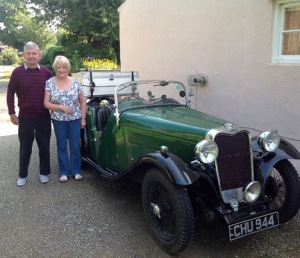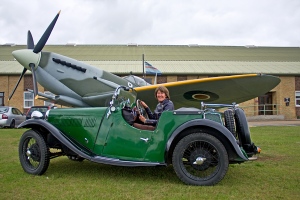CATNAP

Chattie had to tackle Lincolnshire and Yorkshire on her own without the Sprinter. We did a splendid 619 miles. The weather was wonderful. It was ALL wonderful. Ah. Except for a few little hiccups on the way. We travelled the first 170 miles to Steve and Heather Hardwick’s house near Lincoln. Then Chattie refused point blank to start when I tried to put her in the garage. She was as relaxed about it as the cat, but something needed to be done.
A piece of string connected to the starter motor lever and a quick trip to MG Raw’s excellent garage, where they fixed the problem for no charge – may they prosper! – enabled me to make the three fantastic visits to RAF Scampton, Coningsby and Digby.
KWIK WHAT?!
 Then to Yorkshire, where on returning from seeing Ack Greenwood’s grave with friend Roger Gill, we spotted a flat tyre.
Then to Yorkshire, where on returning from seeing Ack Greenwood’s grave with friend Roger Gill, we spotted a flat tyre.
No problem, there was a Kwik Fit garage nearby. We pumped in enough air to get her there; but this was a fast puncture and she wasn’t going to get me to Church Fenton or my evening accommodation. The wheel had to be changed, and I had no jack. “We can’t touch it” was Kwik Fit’s response. I explained that the wheel spinners could be knocked off and I had the correct copper hammer in the car, but didn’t have a jack. “We can’t do it,” was the response, “We don’t know the correct torque setting, and can’t let you go without that because the wheel might come off.”
“My understanding,” I said, “Is that the spinners tighten themselves as the car moves forward, though I haven’t done it myself.”
“Yes, but you don’t know the torque setting so we can’t touch it,” was the response
“Would you just jack it up for us so my friend here can do it?”
Again, the torque argument came again and Kwik Fit felt they would be responsible if the wheel fell off. I asked if there was perhaps an older KwikFitter who might have had some experience with wheel spinners in the past, but the present KwikFitter took it as a personal insult to his expertise and ability; which is not what I had meant at all. In the end, he did put some air in the tyre for me so that Chattie could limp further down the road into the shade of a tree while I called out my excellent breakdown service. While we were waiting, a gentleman came out of the house behind us, offered help, gave us a cup of tea, gave a donation to the RAF BEnevolent Fund. He had served in the RAF many years ago. How nice that was.
 Then the breakdown van came. Callam, pictured here, was the absolute opposite of Kwik-Fitness, and said, ‘Wow! What a lovely car! I’ve never done one of these, but it’s great to have the chance.’ I offered the copper hammer, but he was already reaching for a rubber hammer in the van, and had the wheel off in no time. Turned out he had two family members in the RAF, and he also donated to the RAF Benevolent Fund before he went. (He didn’t bother about any mythical torque problem, being younger and wiser than the Kwik Fit man.) May his career prosper!
Then the breakdown van came. Callam, pictured here, was the absolute opposite of Kwik-Fitness, and said, ‘Wow! What a lovely car! I’ve never done one of these, but it’s great to have the chance.’ I offered the copper hammer, but he was already reaching for a rubber hammer in the van, and had the wheel off in no time. Turned out he had two family members in the RAF, and he also donated to the RAF Benevolent Fund before he went. (He didn’t bother about any mythical torque problem, being younger and wiser than the Kwik Fit man.) May his career prosper!
SINGING IN THE RAIN

 So, saying goodbye to Roger, I set out under a brilliant blue sky for Church Fenton, and thence to Jennifer and Ian’s house for the night. Jennifer is Deryk Hollinrake’s Goddaughter (Dad’s Radar Operator during the war), so I guess that makes us Godsisters. Half way there, the sky blackened and soon I was in the middle of a raging – and I mean raging – thunderstorm; lightning flashes like strobe lighting, and monstrous rain slapping and bouncing off everything; the air thick with it. Like almost every other car on the road, I got off it as quickly as I could, taking refuge with the crowd in the doorway of the Sweet Basil restaurant at a service station (though I think I was wetter than most!). Would they serve anyone coffee while we waited out the storm? No. Though there were tables aplenty, though the conditions outside were freakishly impossible and continued so for about an hour, they would only serve those eating a meal. Thumbs down, Sweet Basil.
So, saying goodbye to Roger, I set out under a brilliant blue sky for Church Fenton, and thence to Jennifer and Ian’s house for the night. Jennifer is Deryk Hollinrake’s Goddaughter (Dad’s Radar Operator during the war), so I guess that makes us Godsisters. Half way there, the sky blackened and soon I was in the middle of a raging – and I mean raging – thunderstorm; lightning flashes like strobe lighting, and monstrous rain slapping and bouncing off everything; the air thick with it. Like almost every other car on the road, I got off it as quickly as I could, taking refuge with the crowd in the doorway of the Sweet Basil restaurant at a service station (though I think I was wetter than most!). Would they serve anyone coffee while we waited out the storm? No. Though there were tables aplenty, though the conditions outside were freakishly impossible and continued so for about an hour, they would only serve those eating a meal. Thumbs down, Sweet Basil.
 I only had about 20 minutes’ driving to go. I set out in a break in the rain, only for it to pound down again. My all-weather clothing didn’t cope with this and soon I was drenched. A little basin of water sat in my lap where I had draped a plastic cloth. Remembering my lovely ‘Aunt’ Monica, who was daunted by nothing the weather could possibly do, I sang my way there, working my way through rain songs and laughing at the sheer scale of the drenching. I was a drowned rat when I arrived. Jennifer set a bath running straight away and lit the bathroom with scented candles: what a fantastic greeting! It was just lovely to stay with her and Ian, and talk about our two Dad’s and their wartime friendship. The sun smiled on us: metaphorically speaking, for our evening together over a LOVELY meal; and literally in the morning.
I only had about 20 minutes’ driving to go. I set out in a break in the rain, only for it to pound down again. My all-weather clothing didn’t cope with this and soon I was drenched. A little basin of water sat in my lap where I had draped a plastic cloth. Remembering my lovely ‘Aunt’ Monica, who was daunted by nothing the weather could possibly do, I sang my way there, working my way through rain songs and laughing at the sheer scale of the drenching. I was a drowned rat when I arrived. Jennifer set a bath running straight away and lit the bathroom with scented candles: what a fantastic greeting! It was just lovely to stay with her and Ian, and talk about our two Dad’s and their wartime friendship. The sun smiled on us: metaphorically speaking, for our evening together over a LOVELY meal; and literally in the morning.
BACK TO SCHOOL
Every airfield has its surprise, and so had the journey down to my mother’s house in Ilkeston. I set the SATNAV to avoid motorways. What a pleasant trip that was! Down country roads, old long Roman roads almost empty of traffic, through towns and villages, while occasionally I could see the motorway running parallel to my left or right, chock-a-block with cars. Negotiating Doncaster was a doddle. Along the way I had the sense of the country and its life: what was farmed in the fields, the type of villages, the different stone, the variation between rustic or industrial, the old mining towns and villages. On the motorway I would have had the monotony of that plain tarmac ribbon cut off from the world. I don’t know if I’ll ever travel that horrible stretch of M1 again after this.
 But the greatest surprise was when I suddenly and completely unexpectedly found myself in Bestwood Village, and there was ‘School Lane’ and the primary school where my father was headmaster for many years before he retired. I hadn’t seen it since the 1970s. A man walking a dog was kind enough to take the picture, and for my mother and me both, this last adventure of the road brought a tear to our eyes.
But the greatest surprise was when I suddenly and completely unexpectedly found myself in Bestwood Village, and there was ‘School Lane’ and the primary school where my father was headmaster for many years before he retired. I hadn’t seen it since the 1970s. A man walking a dog was kind enough to take the picture, and for my mother and me both, this last adventure of the road brought a tear to our eyes.
Back home. Chattie, you are full of gifts and surprises. We did it, girl, and what a great journey!





























 But the greatest surprise was when I suddenly and completely unexpectedly found myself in Bestwood Village, and there was ‘School Lane’ and the primary school where my father was headmaster for many years before he retired. I hadn’t seen it since the 1970s. A man walking a dog was kind enough to take the picture, and for my mother and me both, this last adventure of the road brought a tear to our eyes.
But the greatest surprise was when I suddenly and completely unexpectedly found myself in Bestwood Village, and there was ‘School Lane’ and the primary school where my father was headmaster for many years before he retired. I hadn’t seen it since the 1970s. A man walking a dog was kind enough to take the picture, and for my mother and me both, this last adventure of the road brought a tear to our eyes.





